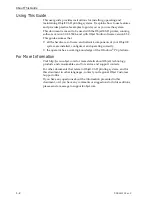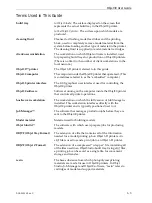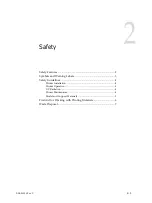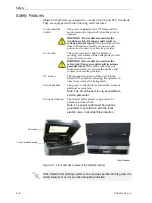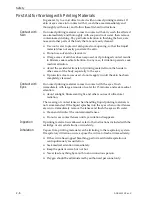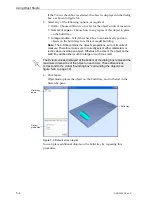
DOC-24000 Rev. C
3–3
Objet30 User Guide
When
installing
the
Objet
software,
you
choose
whether
to
install
it
as
a
client
station
or
as
a
master
station
(server
or
standalone
station).
The
Objet
software
arranges
the
jobs
it
receives
according
to
their
priorities,
model
‐
material
type,
and
other
factors.
In
multi
‐
workstation
configurations,
the
operator
of
the
server—typically
the
production
administrator—has
total
control
over
the
jobs
sent
to
the
3
‐
D
printer,
and
can
prioritize
and
delete
jobs,
review
job
history
and
reprint
a
job,
and
so
on.
Source Files
Objet30
3
‐
D
printing
systems
produce
three
‐
dimensional
models
designed
with
most
3
‐
D
CAD
tools
and
with
other
job
‐
specific
3
‐
D
applications.
Objet30
systems
accept:
•
•
Objet30
systems
feature
the
capability
of
producing
both
types
of
model
files
simultaneously.
STL Files
STL
is
short
for
Standard
Triangulation
Language
.
This
language
views
any
object
as
a
collection
of
surfaces,
and
describes
each
surface
of
the
object
as
a
collection
of
triangles.
For
example,
a
square
can
be
described
as
two
triangles;
a
cube
(six
squares)
as
12
triangles.
Curved
surfaces
need
more
triangles
to
describe
them.
The
higher
the
tolerance
(for
smooth
surfaces),
the
more
triangles
are
needed.
The
result
is
that
high
‐
quality
object
descriptions
mean
very
heavy
files.
Most
CAD
software
can
export
STL
files.
The
Objet30
system
utilizes
these
files
for
building
models
(rapid
prototyping),
and
also
for
directly
making
molds
for
mass
‐
producing
items.
STL
files
are
ASCII
(text)
files.
The
content
of
each
file
begins
with
“solid”
and
ends
with
“end
‐
solid”
(both
lower
case).
Between
these
keywords
is
a
list
of
the
triangles
that
describes
the
faces
of
the
solid
model.
Each
triangle
defines
a
single
normal
vector
directed
away
from
the
solid’s
surface,
followed
by
its
X
‐
Y
‐
Z
coordinates.
These
are
expressed
as
Cartesian
coordinates
and
are
floating
‐
point
values.
The
coordinates
of
all
triangles
should
be
positive
and
should
fall
within
the
volume
of
the
model.
SLC Files
SLC
is
short
for
Stereo
‐
Lithography
Contour
.
SLC
files
describe
two
‐
dimensional
contours
of
the
three
‐
dimensional
models.
These
contour
lines
are
polylines.
SLC
files
are
ASCII
(text)
files
that
save
models
as
a
series
of
slices.
This
means
that
models
based
on
SLC
files
cannot
be
orientated;
only
their
scale
(size)
and
position
on
the
build
tray
can
be
controlled.
For
this
reason,
the
model’s
orientation
must
be
suitable
for
production
before
it
is
saved
as
an
SLC
file.
Because
of
the
nature
of
SLC
files,
the
appearance
of
models
in
Objet
Studio
may
be
different
than
the
solid
‐
object
images
displayed
from
STL
files.


